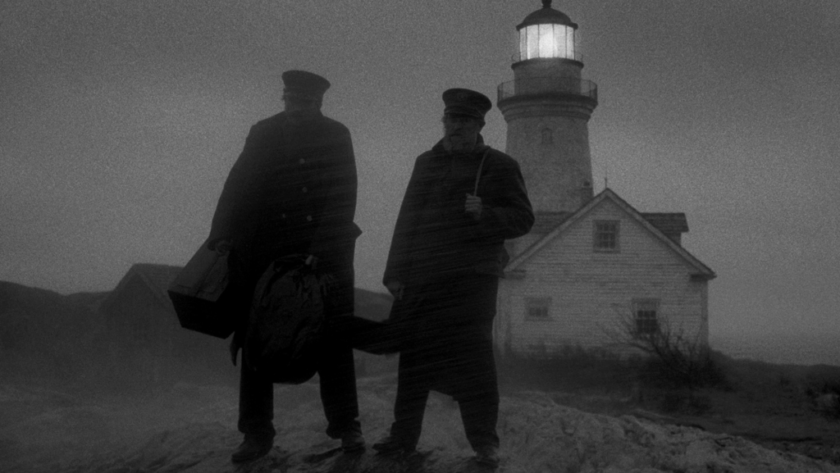Kirese Narinesingh reviews Robert Eggers’ acclaimed new film.
This review contains minor spoilers.
At one point in The Lighthouse, Robert Pattinson’s forlorn, spiritually exhausted character finally kills a bothersome seagull in an outburst of fury and violence, smashing it against the ground vigorously until nothing remains but its feathers and a broken body. The scene leaves the audience visually arrested, unable to move; a type of paralysis only achieved by the work of a director who knows what true horror is, and whose films actively reinvent the genre.
The Lighthouse takes place in 19th-century Maine, set against a harsh landscape of fog and interminable waves that crash onto the lighthouse’s rocks. The endless stream of noise deeply perturbs Pattinson’s Ephraim, while Willem Defoe’s rugged veteran lighthouse keeper, Thomas Wake, is humorously unaffected. Wake seems to have walked straight out of Moby Dick, possessing the nonsensical speech and ridiculous antics of a nineteenth century seaman. The dynamic first appears as no more than “gloomy, quiet youngster meets swashbuckling pirate,” but slowly develops into much more, as the unlikely pair are fated to spend four weeks together in isolation. The film’s premise immediately evokes Bergman’s Persona, with its similar feature of two protagonists on a deserted landscape, one of who becomes increasingly neurotic.
Director Robert Eggers seems to realize this particular situation can go anyway he wants; all creative directions are explored, culminating in a genre-defying blend of horror, comedy and psychological drama.
The film slowly devolves into a dance of unadulterated madness. As both characters learn to coexist, with Ephraim admittedly bearing the brunt of this encounter—he is forced to put up with Wake’s endless stream of farting—they seem to grow increasingly mad. Ephraim’s madness is more pronounced, as he spends his days tormented by a certain seagull, constantly sexually frustrated and masturbating to a small relic of a mermaid. The pitiful performance is masterfully executed, with Pattinson managing to hold his own against an actor of Willem Defoe’s stature.
Defoe’s character Wake, however, may be the key to the film’s madness; he certainly incites it. It’s not that evident at first (or maybe it is, in retrospect) that he might be slightly off, but this slowly changes. Defoe plays the role brilliantly, crafting a madness comprised of bursts of clarity amidst the insanity. He ironically warns Ephraim of the dangers of teetering madness, encouraging him to drink to stave it off, yet simultaneously imposes one unbreakable rule that causes the tension to turn into madness: the lamp at the top of the lighthouse is off-limits. It seems such a trivial thing, but for Ephraim, the lamp becomes a feverish, infectious obsession that Wake passes on to his apprentice. Eggers’ most interesting scenes come forth in these interactions, where the madness of each man seems to intersect and merge, their circumstances producing depravity, dramatic outbursts, and creative insults laced with deep frustration.
Can you blame them for going mad? They’re the only two real characters in the whole movie. Yet it still begs the question of what exactly causes this madness to escalate—is it the barren landscape of the lighthouse, with its burning light and deafening foghorn, or the intense claustrophobia? The film is shot in black and white, allowing Eggers to ironically expand his palette by playing with and revitalizing the nuances of early horror cinema. Similar to films like Persona and The Innocents, the director uses the subtle greyness to explore a descent into the abyss of psycho-sexual neuroses.
Can we consider this a horror film? If so, this is Robert Eggers’ second foray into the genre. His first film, The Witch, was just as grounded in authenticity, with characters left to their own devices. But this film is evidently a different beast. The source of horror is left completely unseen and only hinted at throughout the film: is it the ominous, ubiquitous seagull, or the dream/nightmare of the mermaid, who tantalizingly and mockingly haunts Pattinson’s sexuality?
The Lighthouse has all the exciting suspense and whiplash thrills of horror, but I am still hesitant at the idea of firmly rooting it within the genre. The film feels like more than conventional horror, comprising a mixture of drama and psychological thrills, its protagonists proving more terrifying than any external force. There is no true supernatural entity; only two lonely men on a deserted island left to their own devices.
Once again, I watched Robert Eggers not only exceed but obliterate the expectations that come with making and releasing a horror film, and I enjoyed every minute of it.







